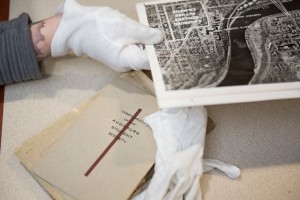A year after it opened, the U.S. Bank Veterans’ Lounge continues to be an important part of the educational journey of Augsburg student vets and has become a quiet respite for the College’s community of veterans.
“Many of our students are commuters, here for long days and on evenings and weekends, so the lounge becomes ‘home base’ when they are on campus,” said Lori York, Augsburg’s School Certifying Official. York also serves as liaison between current and prospective students and the U.S. Department of Veterans Affairs.
Dave Adams, a student in Augsburg’s Masters of Business Administration program, is grateful for the camaraderie and comfort the lounge provides.
“My crew, the group of four who all came together from the same National Guard unit, love the lounge,” Adams said. “It gives us a great place to meet before class and compare notes, as well as a quiet place to go when we have small group breakout sessions.”
Adams also acknowledged his appreciation for the treats–gifts from Augsburg staff members–that often appear in the lounge.
“I was truly dragging when I got to school yesterday. Walking into the lounge to meet the other guys and seeing cookies was just a nice surprise and a simple touch, but it did make a difference in the night.”
But the U.S. Bank Veterans’ Lounge, located in the Oren Gateway Center, is more than just a getaway. It’s also come to represent the connections and community of veterans who are all pursuing their next call.
“When I drop in at the Veterans’ Lounge, I see students meeting each other, sharing their past experiences,” said York. “Today when I stopped by, a student who is in his last semester here was greeting a new student and welcoming him to campus. They immediately jumped into a conversation about their time in the military, where they’ve served, when they got out. These students gravitate toward one another and they gravitate toward the lounge to find their comrades. The lounge is key to building and keeping this community at Augsburg.”
The connection between student vets and U.S. Bank, recognized as a top corporate supporter of veterans and military families, doesn’t end there.
Andy Norgard, pictured above (rear), is one of several Auggies to complete internships at U.S. Bank in recent years. A former member of the Marine Corps and Augsburg’s Student Veteran Representative, Norgard completed a Financial Analyst internship at U.S. Bank last summer and has recently been offered a job at McGladrey, one of the nation’s top accounting firms.
For the second consecutive year, Augsburg was named a Military Friendly® School, a list which is compiled through extensive research and a free, data-driven survey of more than 10,000 VA-approved schools nationwide. Military Friendly Schools have gone above and beyond to provide transitioning veterans the best possible experience in higher education. As of fall 2015, there were nearly 120 active members and military veterans attending Augsburg, a notable number for an institution of Augsburg’s size. The College graduated more than 20 military veterans this past spring and summer.
We are proud to partner with U.S. Bank in its continued support of veterans in both higher education and business.
This post was written by Jay Peterson and originally appeared on Augsburg’s Corporate, Foundation, and Government Relations site.
Dimension 1, Goal 3, Strategy 3: Because we believe in meeting students where they are while challenging them to achieve, Augsburg equips all students to succeed.
 aspects of the impact and personality of the College to life. The project is a deeply collaborative effort, giving students opportunities to hone their skills in research and writing while producing a work for publication and being credited as contributors.
aspects of the impact and personality of the College to life. The project is a deeply collaborative effort, giving students opportunities to hone their skills in research and writing while producing a work for publication and being credited as contributors.